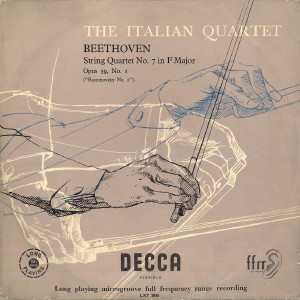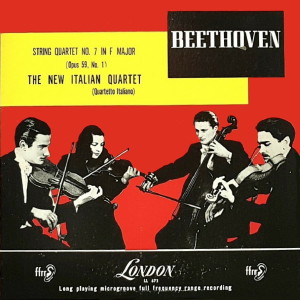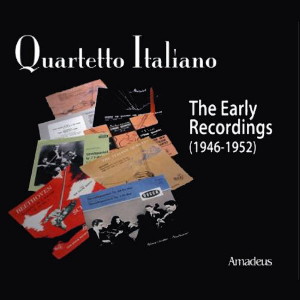 |
Decca
- 1 LP - LXT 2856 - (p) 07/1954
|
 |
| London -
1 LP - LL 673 - (p) 01/1953 |
 |
| Amadeus
- 7 CDs - AMP 007-013 - (p) 2009 |
|
| Ludwig van
Beethoven (1770-1827) |
|
|
|
|
|
|
|
| String
Quartet No. 7 in F major, Op. 59
No. 1 ("Rasumovsky No. 1") |
|
39' 11" |
|
-
Allegro
|
12' 01" |
|
|
-
Allegretto
vivace e sempre scherzando
|
8' 59" |
|
|
-
Adagio molto e mesto
|
12' 14" |
|
|
-
Thème russe (Allegro)
|
5' 57" |
|
|
|
|
|
|
THE NEW ITALIAN QUARTET
- Paolo Borciani, Elisa Pegreffi, violino
- Piero Farulli, viola
- Franco Rossi, violoncello |
|
|
|
|
|
Luogo e data
di registrazione |
|
Accademia di Santa
Cecilia, Roma (Italia) -
20-30 luglio
1952
|
|
|
Registrazione: live
/ studio |
|
studio |
|
|
Producer / Engineer |
|
John Culshaw, Victor
Olof | Gil Went
|
|
|
Matrici
78rpm |
|
DEcca - IAR
597-05
|
|
|
Prima Edizione LP |
|
Decca - LXT 2856
- (1 LP) - (p) 07/1954 - Mono
London - LL 673
- (1 LP) - (p) 01/1953 - Mono
|
|
|
Prima Edizione CD |
|
Paragon/Amadeus -
AMP 007-013 - [7 CDs -
(6°, 5-8)] - (p)
2009 - ADD |
|
|
Note |
|
I riferimenti a
date e codici sono stati
desunti dal libro "Decca
Classical, 1929-2009" di
Philip Stuart.
|
|
|
|
|
At
the end of
1805 Beethoven
received a
commission
from a certain
Count
Rasumovsky to
compose some
string
quartets, with
the proviso
that they
should contain
Russian
melodies, real
or imitated.
The Slavonie
nobleman who
thus ensured
his fame with
posterity was
a notable
figure of his
time. His
father, who
was born of
peasant stock,
rose to be the
lover of
Catherine the
Great of
Russia, and it
has even been
suggested that
the Count of
the quartets
was the
Empress's son.
He was a man
of marked
ability who as
a youth
served with
distinction in
yhe Imperial
navy and later
became Russian
ambassador in
Vienna, a post
which he held
for twenty
years. He first
made
Beethoven's
acquaintance
in 1805 though
he had been an
ardent admirer
of the
composer's
works since
the early
1790's.
The
three quartets
of Beethoven's
Opus 59 are
therefore
known as the
"Rasumovsky".
The idea of
incorporating
Russian themes
into them was
not entirely
happy, for
Beethoven had
little
interest in
musical
"nationalism",
and in any
case would
hardly have
been
sympathetic to
Russian
folk-song. He
used Russian
themes in the
finale of the
first quartet
and in the
trio of the
second; in the
third, he
ignored his
patron's
condition, a
fact which may
be taken as
internal
evidence that
it was irksome
to him. The
true
significance
of the
"Rasumovskys"
will be much
better
appreciated if
their Slavonic
origin is
forgotten.
They are the
first string
quartets of
Beethoven's
"second
period" and in
some respects
the
profoundest
works he had
written up to
their date,
showing a
spiritual and
technical
mastery which
makes them
worthy to
stand beside
the
"posthumus"
quartets of
the composer's
last years.
First
Movement:
Allegro
Professor
Abraham has
written that
few movements
even in
Beethoven are
as tightly
knit
thematically
as the opening
one of the
first
"Rasumovsky".
The first
subject is
announced at
once on the
'cello beneath
repeated notes
for the second
violin and
viola. The
abruptness of
the opening
suggests that
of the
"Archduke"
Trio of five
years later,
as does the
theme itself.
It is composed
ot two parts,
one of
crotchets and
one of
quavers. The
first violin
takes it up on
the dominant,
and soon a dolce
continuation
of the quaver
limb appears.
The second
subject
section is a
good deal more
complex. after
the dominant
of C has been
reached, a
four-bar
'cello solo
precedes a
highly
dissonant
passage, the
second violin
a G pedal with
the other
instruments in
violent
disagreement.
The principal
second subject
theme appears
on the first
violin,
somewhat
irregular in
structure.
Gradually the
texture thins
out, and the
exposition
ends with a
cadence theme
whose pattern
is derived
from the first
subject.
The
development,
which is very
extended and
elaborate, is
divided into
three distinct
sections. In
the first,
figures from
the first
subject group
are discussed
at some
lenght. In the
second, a
quaver figure
from the
cadence theme
is used as the
subject of a
fugato with a
counter-subject
not otherwise
heard in the
movement. The
final section
is less
complex in
texture and
leads to
recapitulation.
The coda is
kept light in
mood to bring
relief from
the long
working-out.
after a ff
apotheosis of
the opening
theme, the
latter's first
limb is
bandied about
with a
refreshing
artlessness,
accompanied in
its progress
by rollicking
triplets.
Second
Movement:
Allegretto
vivace e
sempre
scherzando
The
second
movement long
formed a
stumbling-block
to Beethoven's
contemporaries;
they had
accepet his
substitution
of the scherzo
for the
minuet, but
found it hard
to stomach
such a
capricious,
unorthodox
movement as
this allegretto
vivace e
sempre
scherzando.
It is in
sonata-form -
as are full
four movements
of the quartet
- and has non
trio, but its
chief
peculiarity
lies in the
fact that the
exposition
does not
really begin
until bar 101;
all that are
heard
previously are
melodie and
rhythmic
fragments
which
gradually
build up into
the material
of the
movement. Once
this is clear,
it is not
difficult to
follow the
music. The
development
and coda
sections,
being
traditionally
free,
doubtless
alarmed
conservatives
less than the
recapitulation,
wich Beethoven
begins with a
dolce
theme first
heard in the
twenty-third
bar of the
movement
instead of
with the
expected
semiquaver
phrase.
Third
Movement:
adagio molto e
mesto
In
his sketchbook
Beethoven
wrote at the
head of this
movement: "A
weeping willow
or acacia tree
on the grave
of my
brother". The
implied
allusion has
puzzled
historians,
since both
Beethoven's
brothers were
alive in 1806
and, he was
not, in any
case,
particularly
fond of either
of
them. Clearly
the entry
cannot be
taken
literally, but
it suggests
the elegiac
mood of the
music. This is
one of
Beethoven's
most
transcendentally
beautiful
adagios. Like
the other
movements of
the quartet it
is in
sonata-form.
The opening
eight-bar
theme with its
sorrowful
droops is
given out by
the first
violin, and is
followed by a
second subject
in C minor,
smoother and
upwardrising.
The latter
appears later
in A flat to
start the
development,
which contains
a D major
episode with
an extended
lyrical theme
for the first
violin, which
is derived
from the
second
subject.
Recapitulation
is shortened,
and the coda
is mainly a
straightforward
repetition of
the opening
theme. Running
scale passages
for the first
violin lead
straight into
the final
movement.
Fourth
Movement:
Thème russe
(Allegro)
This
is based on a
Russian
folk-song, but
there is
nothing in the
movement to
suggest
Slavonic art.
The function
of Beethoven's
second
subject, a dolce
tune in smooth
crotchets, is
to provide
rhythmis
contrast in
the exposition
and
recapitulation;
and it is
followed by a
"fanfare"
theme which is
briefly
discussed in
the
development.
Otherwise, the
Russian theme
generates all
the music, and
is extremely
well qualified
to do so,
being plastic
and composed
of a number of
rhythmically
diverse
figures almost
suggesting a
fugue subject.
The movement
is
marvellously
organized and
if it doe not
equal the
others in
emotional
power,
provides a
striking
example of
Beethoven's
resource and
inspired
craftsmanship
when
confronted by
a task not of
his own
choosing.
LXT
2856
(rectus)
|
|
|